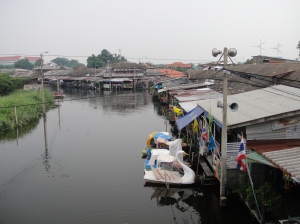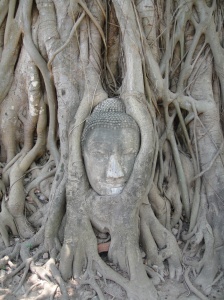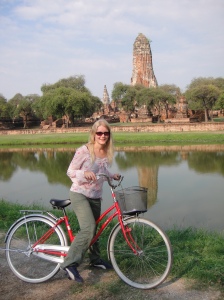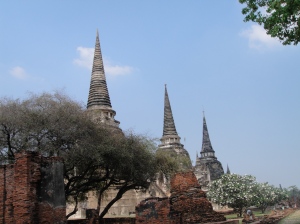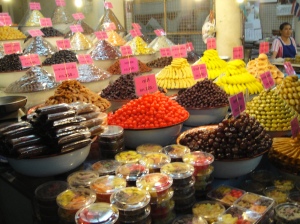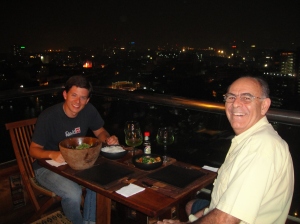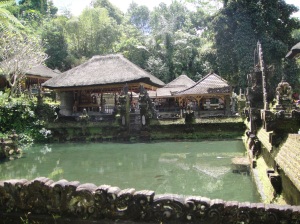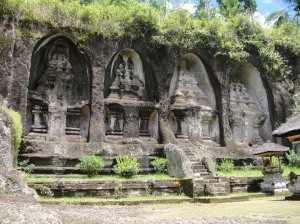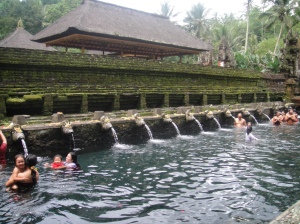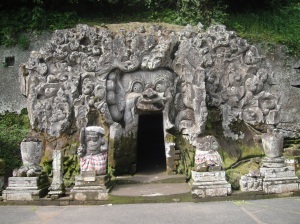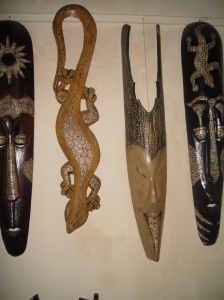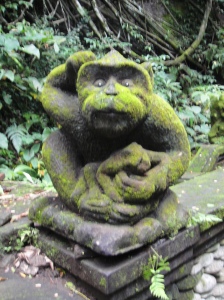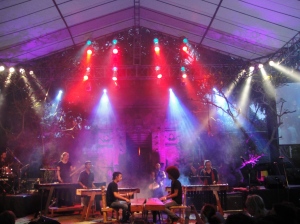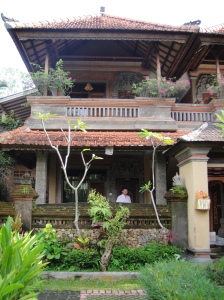Inspired by the great cooking class at Luang Prabang, we thought it might be nice to learn also a bit more about Balinese and Indonesian cooking in general.
We met our chef Desak and four other students at 9 in the morning the centre of Ubud and headed to the nearby market. Interestingly, the market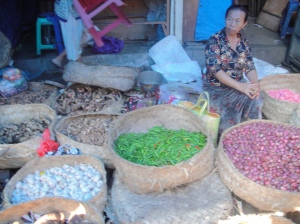 operates as a food market in the early morning and as a souvenir market during the rest of the day. We got there right about the time before the shift occurs. The market was probably a bit less interesting than the one in Luang Prabang, but we still learned about some new vegetables (e.g. bitter melon) and spices (e.g. turmeric, which is one of the central spices for Balinese cuisine). One of
operates as a food market in the early morning and as a souvenir market during the rest of the day. We got there right about the time before the shift occurs. The market was probably a bit less interesting than the one in Luang Prabang, but we still learned about some new vegetables (e.g. bitter melon) and spices (e.g. turmeric, which is one of the central spices for Balinese cuisine). One of  students of the cooking class was eager to try durian and we thought it was a good idea to give durian a second chance for us. Desak helped us to choose a good durian – she asked vendors to cut durian open and checked whether it looked fine. Several durians proved not to be good enough, but we as non-experienced durian eaters wouldn’t have known that without her insight.
students of the cooking class was eager to try durian and we thought it was a good idea to give durian a second chance for us. Desak helped us to choose a good durian – she asked vendors to cut durian open and checked whether it looked fine. Several durians proved not to be good enough, but we as non-experienced durian eaters wouldn’t have known that without her insight.
The cooking venue of this class was, again, not as nice as Tum Tum Cheng’s in Luang Prabang, but we still learned to make quite a few dishes: “saffron” sauce (actually yellow turmeric), Balinese sauce, peanut sauce and sambal sauce, which are bases for many Balinese dishes, Bakso (Balinese soup with chicken balls), Pepes ikan (banana leaf wrap with fish filling), Satay lilit (chicken or fish satay), Urab (Balinese boiled vegetable dish), Nasi Goreng (fried rice), Mee Goreng (fried noodles), Gado-Gado (Indonesian vegetable dish with peanut sauce) and Dadar Gulung (pancake with coconut filling). After cooking all this, we had the feast of eating all the dishes – a bit too spicy for a hot day, but quite tasty :)!
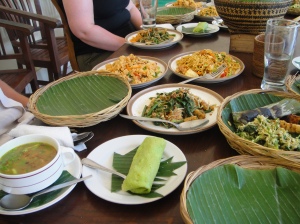
We ended the feast with the durian that we had gotten from the market earlier. It’s said that durian smells like hell and tastes like heaven. We didn’t quite agree. It does smell bad indeed, but its taste is not what we would call heavenly. It’s rather sweet and tastes like a mix between a melon and papaya, but with the creamy texture of an overly ripe banana. It’s ok to try once, but taken the bad smell and the hassle with choosing and opening it, it’s not really worth taking it into your daily fruit menu.
After the cooking class, we headed back to the market, which had turned into souvenir bazaar by that time. We did some souvenir shopping and headed back to our guesthouse. As our guesthouse was located at Penestanan, which is known for its painters, we found it a good neighbourhood to look around for a few more art shops and do some art shopping.
In the evening, I treated myself with a Balinese massage. I happened to find a really nice spa for that – Kiradi Spa(www.spainubudbali.com). If any of you ever comes to Ubud, I really recommend this place.
As Bali, and Ubud in particular, is famous for its traditional dances, we thought 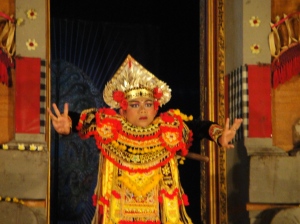 it might be worthwhile to end our stay in Bali with a dance show. So, we caught a Legong dance performance performed at open air stage of the Pura Dalem Ubud temple by the Sekaa Gong Karyasa troupe. The dancers were really mesmerising – every movement of their body was controlled up to their fingertips, facial expressions and even glances, and the costumes were also wonderful. All dances were accompanied with a live gamelan orchestra. All this was really wow! It was only sad that were many more performers on stage than people in the audience (only 6 people in all), but we tried to make it up with good applauses.
it might be worthwhile to end our stay in Bali with a dance show. So, we caught a Legong dance performance performed at open air stage of the Pura Dalem Ubud temple by the Sekaa Gong Karyasa troupe. The dancers were really mesmerising – every movement of their body was controlled up to their fingertips, facial expressions and even glances, and the costumes were also wonderful. All dances were accompanied with a live gamelan orchestra. All this was really wow! It was only sad that were many more performers on stage than people in the audience (only 6 people in all), but we tried to make it up with good applauses.
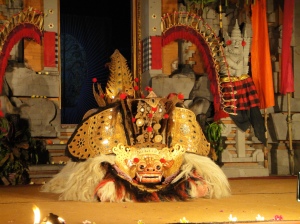
After the dance show, we had dinner in restaurant with a nice river view and said farewell to Indonesia.

